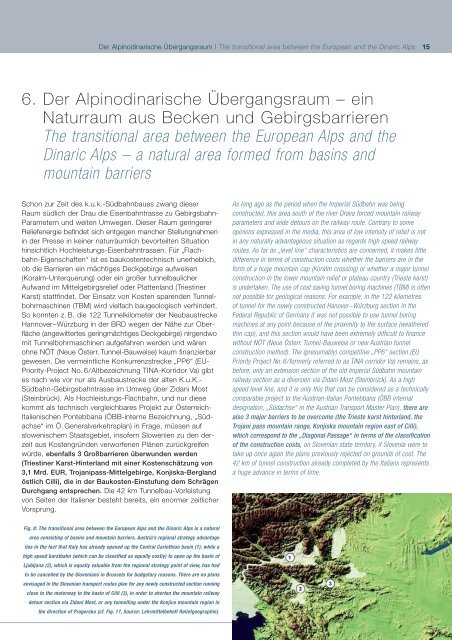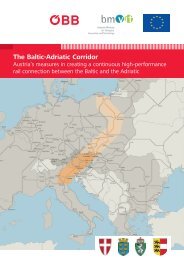Inhalt | Contens - baltic-adriatic.eu
Inhalt | Contens - baltic-adriatic.eu
Inhalt | Contens - baltic-adriatic.eu
Erfolgreiche ePaper selbst erstellen
Machen Sie aus Ihren PDF Publikationen ein blätterbares Flipbook mit unserer einzigartigen Google optimierten e-Paper Software.
Der Alpinodinarische Übergangsraum | The transitional area between the European and the Dinaric Alps 15<br />
6. Der Alpinodinarische Übergangsraum – ein<br />
Naturraum aus Becken und Gebirgsbarrieren<br />
The transitional area between the European Alps and the<br />
Dinaric Alps – a natural area formed from basins and<br />
mountain barriers<br />
Schon zur Zeit des k.u.k.-Südbahnbaues zwang dieser<br />
Raum südlich der Drau die Eisenbahntrasse zu Gebirgsbahn-<br />
Parametern und weiten Umwegen. Dieser Raum geringerer<br />
Reliefenergie befindet sich entgegen mancher Stellungnahmen<br />
in der Presse in keiner naturräumlich bevorteilten Situation<br />
hinsichtlich Hochleistungs-Eisenbahntrassen. Für „Flachbahn-Eigenschaften“<br />
ist es baukostentechnisch unerheblich,<br />
ob die Barrieren ein mächtiges Deckgebirge aufweisen<br />
(Koralm-Unterquerung) oder ein großer tunnelbaulicher<br />
Aufwand im Mittelgebirgsrelief oder Plattenland (Triestiner<br />
Karst) stattfindet. Der Einsatz von Kosten sparenden Tunnelbohrmaschinen<br />
(TBM) wird vielfach baugeologisch verhindert.<br />
So konnten z. B. die 122 Tunnelkilometer der N<strong>eu</strong>baustrecke<br />
Hannover–Würzburg in der BRD wegen der Nähe zur Oberfläche<br />
(angewittertes geringmächtiges Deckgebirge) nirgendwo<br />
mit Tunnelbohrmaschinen aufgefahren werden und wären<br />
ohne NÖT (N<strong>eu</strong>e Österr. Tunnel-Bauweise) kaum finanzierbar<br />
gewesen. Die vermeintliche Konkurrenzstrecke „PP6“ (EU-<br />
Priority-Project No. 6/Altbezeichnung TINA-Korridor Va) gibt<br />
es nach wie vor nur als Ausbaustrecke der alten K.u.K.-<br />
Südbahn-Gebirgsbahntrasse im Umweg über Zidani Most<br />
(Steinbrück). Als Hochleistungs-Flachbahn, und nur diese<br />
kommt als technisch vergleichbares Projekt zur Österreich-<br />
Italienischen Pontebbana (ÖBB-interne Bezeichnung, „Südachse“<br />
im Ö. Generalverkehrsplan) in Frage, müssen auf<br />
slowenischem Staatsgebiet, insofern Slowenien zu den derzeit<br />
aus Kostengründen verworfenen Plänen zurückgreifen<br />
würde, ebenfalls 3 Großbarrieren überwunden werden<br />
(Triestiner Karst-Hinterland mit einer Kostenschätzung von<br />
3,1 Mrd. EUR, Trojanipass-Mittelgebirge, Konjiska-Bergland<br />
östlich Cilli), die in der Baukosten-Einstufung dem Schrägen<br />
Durchgang entsprechen. Die 42 km Tunnelbau-Vorleistung<br />
von Seiten der Italiener besteht bereits, ein enormer zeitlicher<br />
Vorsprung.<br />
Fig. 8: The transitional area between the European Alps and the Dinaric Alps is a natural<br />
area consisting of basins and mountain barriers. Austria’s regional strategy advantage<br />
lies in the fact that Italy has already opened up the Central Carinthian basin (1), while a<br />
high speed karstbahn (which can be classified as equally costly) to open up the basin of<br />
Ljubljana (2), which is equally valuable from the regional strategy point of view, has had<br />
to be cancelled by the Slovenians in Brussels for budgetary reasons. There are no plans<br />
envisaged in the Slovenian transport routes plan for any newly constructed section running<br />
close to the motorway to the basin of Cilli (3), in order to shorten the mountain railway<br />
detour section via Zidani Most, or any tunnelling under the Konjice mountain region in<br />
the direction of Pragersko (cf. Fig. 17, Source: Lehrmittelbehelf Reliefgeographie).<br />
As long ago as the period when the Imperial Südbahn was being<br />
constructed, this area south of the river Drava forced mountain railway<br />
parameters and wide detours on the railway route. Contrary to some<br />
opinions expressed in the media, this area of low intensity of relief is not<br />
in any naturally advantageous situation as regards high speed railway<br />
routes. As far as „level line“ characteristics are concerned, it makes little<br />
difference in terms of construction costs whether the barriers are in the<br />
form of a huge mountain cap (Koralm crossing) or whether a major tunnel<br />
construction in the lower mountain relief or plateau country (Trieste karst)<br />
is undertaken. The use of cost saving tunnel boring machines (TBM) is often<br />
not possible for geological reasons. For example, in the 122 kilometres<br />
of tunnel for the newly constructed Hanover–Würzburg section in the<br />
Federal Republic of Germany it was not possible to use tunnel boring<br />
machines at any point because of the proximity to the surface (weathered<br />
thin cap), and this section would have been extremely difficult to finance<br />
without NÖT (N<strong>eu</strong>e Österr. Tunnel-Bauweise or new Austrian tunnel<br />
construction method). The (presumably) competitive „PP6“ section (EU<br />
Priority Project No. 6/formerly referred to as TINA corridor Va) remains, as<br />
before, only an extension section of the old Imperial Südbahn mountain<br />
railway section as a diversion via Zidani Most (Steinbrück). As a high<br />
speed level line, and it is only this that can be considered as a technically<br />
comparable project to the Austrian-Italian Pontebbana (ÖBB internal<br />
designation, „Südachse“ in the Austrian Transport Master Plan), there are<br />
also 3 major barriers to be overcome (the Trieste karst hinterland, the<br />
Trojani pass mountain range, Konjiska mountain region east of Cilli),<br />
which correspond to the „Diagonal Passage“ in terms of the classification<br />
of the construction costs, on Slovenian state territory, if Slovenia were to<br />
take up once again the plans previously rejected on grounds of cost. The<br />
42 km of tunnel construction already completed by the Italians represents<br />
a huge advance in terms of time.



